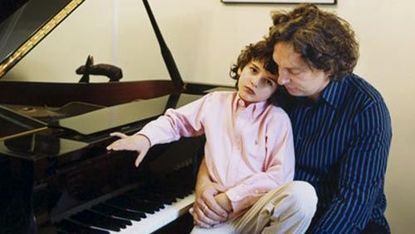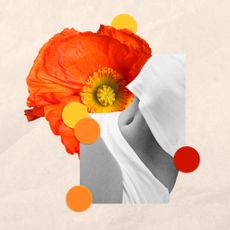
Jim Papoulis pushes hard on the accelerator, racing through the blackness back to Manhattan from the eating-disorder clinic in Princeton, where his frail and delirious wife, Stephanie, is sobbing on the floor.
He runs into their Upper West Side brownstone on this late June night, riffles through Stephanie's purse, and plucks out a business card. Holding his breath, he punches the digits into the phone. It's 9:30 at night. Crazy, he knows. But he's a desperate man.
"Do you remember my wife, Stephanie Martini?" Jim asks Dr. Mehmet Oz, of Oprah fame. Though Dr. Oz had only met Stephanie briefly, at a luncheon the previous May, of course he remembers her, he says. Stephanie Martini is not someone you forget. "I need your help," Jim says as the tale tumbles out of his mouth.
In just a few short weeks, Stephanie has morphed from a vivacious, energetic, brilliant woman, Jim says, to a person who has trouble speaking, eating, and walking. She's been in and out of the hospital, and no doctor has been able to tell him what the hell is wrong with her — that's why she's in Princeton. Her friends, completely frantic, thought that since some 30 pounds had melted off her 5-foot-7 frame seemingly overnight, maybe she had an eating disorder. Maybe a B-12 deficiency could explain all her bizarre symptoms.
But now that she's locked down in the clinic with a bunch of 15-year-olds, it's clear that something much more serious is ravaging her body and her mind. Stephanie, a Phi Beta Kappa graduate of Vassar College — a former soap-opera actress, for Christ's sake — can't even tell the difference between shampoo and conditioner. Just the other day, her sister, Andrea, looked Stephanie in the eye and thought, This is not my sister; I know this is crazy, but could she be possessed? Is that possible? As Stephanie crashes between screaming and sobbing, cursing and withdrawing, everything familiar about this 45-year-old woman is gone. Could someone this high-functioning, this capable, just crack up and completely lose her mind in a month? Jim asks the doctors daily. Yes, they say, but more likely she's severely depressed and should be admitted to the psych ward - though every time they say that to Stephanie, she screams, "I'm not fucking depressed! Something's wrong with my body, and I don't know what it is!" Then she tries to escape, and Jim has to physically restrain her until she crumbles, depleted and defeated, to the floor.
Yesterday, the head of the clinic finally told Jim that if this were his wife, he would get her to the best neurology clinic in the country — New York University Medical Center — and have them exhaust every possiblediagnosis. Jim called. There is a six-month wait. Stephanie clearly does not have six months.
"Can you help us?" Jim asks Dr. Oz.
Five minutes later, the phone rings in the brownstone. It's the neurology department at NYU. Stephanie will be transferred first thing in the morning.
Stay In The Know
Marie Claire email subscribers get intel on fashion and beauty trends, hot-off-the-press celebrity news, and more. Sign up here.
When they wheel her in on Saturday, she weighs less than 100 pounds and looks, says her neurologist, Dr. Harold Weinberg, like she's been through a Holocaust experience. She's barely verbal, except when she's cursing at him. "Are you like all the other bastards?" she screams, and then refuses to let anyone touch her for even the most rudimentary tests for three days. This must be a psychiatric case, Dr. Weinberg thinks.
But with each passing day — with each passing hour — Stephanie gets worse. She's no longer able to lift her head to throw up, and she can't control her bowels; she chokes on her drool as her body convulses with seizures. The doctors begin to run neurological tests on her. One by one, they rule out everything that might explain her symptoms — thyroid issues, infections, vitamin deficiencies — until only one explanation remains. They tap her spine and send the fluid out to Cleveland, to the only laboratory in the entire country that can run this particular test to confirm their suspicions.
It will take 10 days to get the results. In the meantime, doctors continue to hope that this is, indeed, some-thing psychological. "My sister is not crazy," Andrea, exasperated, says to one doctor.
"I just want to caution you, that would be the better scenario," the doctor replies. "If you're going to pray for something, pray for it to be something psychiatric."
The day Stephanie came screaming into the world — on Valentine's Day, of course — her grandfather stood on his head, right there in the Philadelphia hospital. That was the kind of reaction people had to Stephanie. You just couldn't help but be drawn in by her crackling charisma. "Stephanie did more things in a day than I did in a month," says Andrea, who clearly idolizes her. "She was always in motion. She would exhaust all of us." Stephanie was so busy chasing down life that her father, a college professor, had to sing "Ah, Camminare" nightly — in Italian — to get the whirling dervish to fall asleep.
She danced naked with her brother and sister, singing the off-color lyrics to "Hair" at the top of her lungs; she also petitioned her Catholic church to accept female altar girls (but was denied). "She was an incredibly intellectual person but an actress at the same time," says her close friend Dawn Trachtenberg. "I think that a lot of people didn't really know the depth of her intellect and the seriousness that was underneath the drama and theatrics that they saw."
But that's the woman — "the very smart drama queen," he calls her — that Jim Papoulis, himself an interesting cocktail of Ivy League athlete and music conductor/composer, fell in love with and married 18 years ago. They lived as near a fairy-tale life as can be written — walking their three children through Central Park to school every day, collecting interesting and artsy friends, and throwing rocking parties, such as Stephanie's yearly "Come With a Heart-On" Valentine's/birthday blowout.
All of which would have made it easy to peg and dismiss Stephanie as just another pampered and entitled uptown wife — except that she was genuinely grateful for, and wanted to share, her good fortune. She worked tirelessly to raise scholarship funds at the Rudolf Steiner School, her children's very expensive private school, so that less-fortunate kids could also attend. And after Jim's music company, which Stephanie managed, became successful providing pop tunes for the likes of Aretha and Celine, film scores, and orchestral pieces, Stephanie created a foundation for children's charities in 1999, called the Foundation for Small Voices; their gift drive has given away tens of thousands of presents over the past eight years
"Stephanie was a person who you stood back in awe of and watched the speed at which she was able to get things done," says Dawn, with whom Stephanie volunteered at the Steiner School. "Many of us would look at her and say, 'We can't keep up with you. You get done in a day what it would take 10 people to do.'"
And so, the day Stephanie stood outside the school in late May, struggling with her BlackBerry and telling Dawn that she felt like her brain could not keep tabs on all of the things she needed to do, Dawn just thought, Of course you can't. You simply can't cram that much living into a life. What else would you think?
The spelling mistakes are the first clue. Stephanie simply does not make spelling mistakes. But it is the day in late May when Stephanie tells Jim she can't read a phone number he had just e-mailed her that he knows something is wrong. There's a helplessness in her voice. It strikes Jim right in the gut.
He has ignored some weird behavior in the past few months. Stephanie, normally optimistic and loving, was suddenly plagued with irrational fears — keeping him up late at night worrying that if he didn't work for 16 months they would be homeless — and it was starting to annoy him. Stomping around, her brow constantly furrowed, he says, she just wasn't fun anymore. One day he called his oldest daughter's cell phone while he was away on a business trip. All three kids were hiding out in the park close to dinnertime. "We just want to stay out of Mom's way," his daughter explained. "She gets so upset." Jim was stumped. Stephanie was a nurturing mother. So nurturing that their youngest son, Demitri, could only calm himself when upset and drop off to sleep at night by putting his finger in her belly button. She was his security blanket.
But by now, in late May, her symptoms can no longer be ignored. Stephanie is forgetting things; her weight has plummeted from 130 to 105; she is unsteady on her feet; her handwriting looks like that of a young child — she can't even form the S in Stephanie. She blames it all on stress. Everyone believes her. Between refinancing and renovating the brownstone, as well as juggling the foundation work and the school fundraising, she has simply hit a breaking point, she says, and needs to unplug for a few days. She heads up to her sister's place an hour outside the city but just gets worse. Andrea begs her to see a neurologist, but Stephanie refuses. "I think she was afraid that she was losing her mind, going crazy," Andrea says. "And that scared her."
Stephanie is clearly scared by the time she is taken to Princeton in mid-June. If anything happens to me, she says to Dawn and another friend, please tell my children and my husband I love them, and tell funny stories about me. "I think," says Dawn, "she knew that she was not going to come out of this."
Her loved ones are considering that possibility, too. As she lies in bed on the neurology floor at NYU, some days — like the time she hums along with her favorite musical, Wicked — they cling to hope. But most days, she seems catatonic. Seven weeks into this nightmare, they still have no idea why.
"It's called Creutzfeldt-Jakob Disease," Dr. Weinberg says.
It's 4th of July weekend when Stephanie's neurologist gathers the family together. The test results won't be back for a week or so, he says, and while we should all hope for the best, it is time to prepare for the worst. CJD is a very serious brain disorder, he says. Please don't Google it.
But Jim fires up his computer anyway, and for the next six hours, he reads with horror about this mysterious and controversial disease. CJD (aka "classic CJD") is one of a group of degenerative brain disorders known as TSEs (transmissible spongiform encephalopathies) — like mad-cow disease in cattle — in which it is believed that an infectious and indestructible form of a protein called a prion invades the brain and creates spongelike holes. As the brain disintegrates, the human or animal descends into dementia and loses all control of its body. There is no treatment for CJD; it is 100 percent fatal.
All the symptoms — the weight loss, the personality transformation — fit. So when the test results on Stephanie's spinal fluid come back from the government-funded surveillance center at Case Western University in Ohio a week or so later indicating that she does, indeed, appear to have CJD, Jim is not surprised. It barely even registers when a woman from the Centers for Disease Control shows up at the hospital and gives him her card. She is probably there to make sure his wife doesn't have mad-cow disease, he thinks.
The public was first introduced to bovine spongiform encephalopathy (BSE), or mad-cow disease, in 1986, via images on the news of staggering and falling cows throughout the English countryside. Scientists traced the likely cause of the epidemic to the shocking practice of diseased cows being ground up and fed to other cows. Ranchers had in effect taken an animal that was an herbivore and not only forced it to be a carnivore but also a cannibal.
It had been assumed that CJD, the very rare human TSE, could not be contracted from eating diseased meat (beyond isolated cases involving human cannibalism in New Guinea); it almost always occurred spontaneously, for no reason beyond apparent bad luck. But then, in 1996, alarm broke out in British medical circles when 10 citizens came down with a new type of CJD, which would be identified as variant CJD (vCJD); another 156 cases in the U.K. would be diagnosed by 2007. Scientists linked vCJD to the victims' eating mad-cow-contaminated beef, prompting the government to slaughter and incinerate up to 4.5 million cows, a full-blown catastrophe for the British beef industry.

Turned out the appalling practice of feeding diseased cows to other cows was not confined to the U.K. The United States — also home to cannibal cattle — was terrified of its own outbreak of mad cow and instituted a ban on the practice the following year. Would that step be enough to ward off a potential epidemic? Countless hypotheticals remain. Do any of the estimated 200,000 "downer" cows among the cattle population of 105 million have mad cow — the striking characteristic of which is an inability to stand up? And if so, how easy would it be for one to find its way into the food supply (particularly in light of this past February's meat recall, the largest in history, after a meatpacker was found to have allowed sick animals into the U.S. food supply and 143 million pounds of beef had already been consumed)? Or rendered into chicken feed and fed to vast numbers of chickens — the excrement of which is then fed back to vast numbers of cows, infecting them? Another concern is the fact that in humans, CJD, which mimics so many other diseases in its early stages, may be underdiagnosed or misdiagnosed. A Yale study in 1989 autopsied the brains of people who had been diagnosed with Alzheimer's disease and found that 13 percent actually had CJD. If 4.5 million people are diagnosed with Alzheimer's each year, that could translate to nearly 600,000 people dying, unknowingly, of CJD, instead of the one-in-a-million statistic the government puts out.
Compounding the mystery, it seems each new scientific finding upends what little is known of CJD. In a 2002 lab study, some mice injected with the BSE infectious agent developed the symptoms associated with vCJD, while others showed symptoms of classic CJD. The conclusion is that it could be possible for some patients with what seems to be classic CJD to have actually been infected with mad cow. "Now people are beginning to realize that because something looks like CJD, they can't necessarily conclude that it's not linked to [mad-cow disease]," Dr. Laura Manuelidis, a researcher on the Yale Alzheimer's study, has said.
Most troubling of all is the theory that perhaps vast numbers of Americans may be silently incubating CJD and vCJD right now. Scientists believe that the incubation period — the time from infection to the manifestation of symptoms — could be decades, maybe as long as 50 years. Which is to say: Could Stephanie, who had been a vegetarian for 20 years, simply start yelling at her kids and forgetting how to spell because of contaminated meat she'd eaten 30 years before?
"I think that we're on the tip of the iceberg for this disease," says Howard Lyman, the former cattle rancher who introduced Americans to the concept of cattle cannibalism on Oprah, and then was promptly sued, along with Oprah, by a group of Texas cattlemen. "We'll look back 10 or 15 years from now and say, 'Oh, my God, why couldn't we see that disaster coming?'"
CJD of the bad-luck variety is what the doctors tell Stephanie's family she has. "We have a diagnosis but can't explain why she got it," they say. "We honestly don't know."
In the end, it doesn't really matter. The question is purely academic. Stephanie will die. Quickly.
You should remove her feeding tube, the doctors tell Jim as he moves Stephanie to a hospice. "What the fuck," he says. "I'm supposed to starve my wife?" They explain to him that there will come a point when her brain no longer tells her body to digest food, and she will choke to death. And, anyway, the doctors say, she probably will not live through the night. But she does.
Andrea and Jim alternate nights, pushing the spare bed next to Stephanie's and holding her hand as they sleep. They read her her old favorites, The Velveteen Rabbit and The Giving Tree. Friends visit and tell Stephanie's mother, Pat, stories about her.
As the days bleed into weeks, Stephanie wastes away in front of their eyes. It's a hellish limbo; everyone's life is on hold. Jim cancels the family's annual month-long trip to the beach house in Maine, the first summer he has missed in 35 years. His oldest daughter, Caryl, a star volleyball player, refuses to attend the sports camp at Dartmouth she had been so looking forward to. Instead, she goes to the hospice and hovers in the visitors room. She wants to remain physically close to her mother but not look at her, because looking at her makes her burst into tears. And so Caryl is the first to say her good-byes in mid-August, followed by Claire, the middle child, who plays the violin by Stephanie's bed. Demitri, just 6 years old, does not really understand what is going on. He thinks maybe Mommy's having a baby and that's why she's in a hospital.
How do you mourn the living? Stephanie's mother perches next to her daughter's bed and waits for a miracle, telling Father Joe as he makes his rounds to leave Stephanie be, she is not ready yet. Jim and Andrea try to be realistic. "The percentage of people who have survived with this disease is zero," Jim says. "So you can't really argue with that." Trying to prepare for the grief that lies ahead, they read books — Deepak Chopra for Andrea and a Buddhist book called Grieving Mindfully for Jim. They think about eulogies and funeral services. Life is lived in three-hour increments. Dinner is never planned.
It's September 21, Caryl's 15th birthday, and for the first time in months, she is actually looking forward to something.
She was a little reluctant to have a party at first — how can you even smile when your mother is dying? — but her family convinced her that her mother would want her to celebrate. Stephanie is crazy for birthdays. And so — even though she had been doubting the very existence of God since her confirmation in May, right when her mother got sick - Caryl prayed all last night that her mother would not die today.
Andrea runs with a pink theme — Stephanie's favorite color — and pulls out rosy-hued bowls and tablecloths and candles left over from Stephanie's infamous birthday bashes. She unloads the overflowing bags of food. Normally the sous-chef, Andrea attempts to make Stephanie's specialty, the one she reserves for special occasions — pumpkin tortellini with garlic and pine nuts — all on her own.
At 2:22, the phone rings. It's her mother. Stephanie is dead.
Caryl bounces into the brownstone five minutes later, her cheeks still flushed with excitement from her volleyball tournament. Jim tells her that her mother just passed, and Caryl flees downstairs to her room. The celebration, she says, is off.
As soon as Demitri hears the news, he wails, his little-boy screams so heartbreakingly loud that Jim takes him outside, away from the girls, trying to contain him. And suddenly, after about five minutes, he stops crying completely. Lifting his head, he looks into his father's eyes. "Well, I have to go get ready for my sister's 15th birthday now," he says. "It's Caryl's birthday today, and we have to help her." Demitri walks back into the kitchen and hangs pink decorations with his aunt until, eventually, Caryl returns upstairs as guests arrive with beautifully wrapped gifts. As Caryl opens them, Stephanie's friends try to make jokes: You should steal her birthday. You don't have to keep this one; pick another day.
"It was almost as though it was orchestrated," Andrea says of Stephanie's dying on Caryl's birthday. "Maybe Stephanie knew that this was the only way we could handle it — all being together." Stephanie's Catholic mother takes a more religious view. "Stephanie tried so hard to be there," she says. "I hope I can tell Caryl sometime that your mom loved you so much that she left on your birthday, because she was going to be born again in another place, in heaven."
Inside the ballroom at New York's Grand Hyatt, people laugh and eat and hug as they flit from the cookie-decorating table to the brunch line, pause by the face painter and the magician, then make their way over to the mountain of gifts waiting to be wrapped. Hundreds of guests bundle Leapsters and Candylands into shiny sheets of paper as Jim conducts a children's choir and plays the piano while a booming baritone belts out "Where Are My Angels," the first song Jim wrote after Stephanie died, two-and-a-half months ago.
This party, the eighth annual gift-drive brunch for the Foundation for Small Voices, was Stephanie's pet project. But Jim can't let it go. After she died, he found a file on her computer meticulously outlining every detail for organizing it, as well as a five-year plan for the foundation, written right before she got sick. For Jim, these future plans feel like Stephanie's legacy, and so, he says, "We're trying to live it all out." He doesn't know what else to do. Stephanie was the planner.
"I haven't really been taking care of myself, taking care of my own needs, psychologically and whatever," he admits the day before, sitting in his cluttered basement music studio. Losing himself in work — so far that's how he's managed to not think about Stephanie's clothes hanging there in the closet. But he knows it's time to somehow trudge forward, into the unknown. "I'm sort of trying to find my way now," he says. "I don't know what I'm going to do about changing my life as a father. I don't know what is the right way to be," he says of trying to meet the needs of all of his children by himself. "I'm trying to figure out how much freedom to give my daughter to get really mad about things and be really bitchy and talk back to me. I want to give her a free card to do that, in a way, because she needs to let some of that out, but I don't know when it crosses into being a 15-year-old who needs to be disciplined. What is mourning? What is her just being 15?"
And so he does the best he can. He lights a candle with Demitri every night so that his son can talk to his mother. One of those nights, he told Demitri that some Native Americans think that when a person dies, they come back to earth as an animal. "What kind of animal would your mother be?" he asked Demitri. "What's an animal that can do everything really well?" Demitri responded.
And so now Jim will try to do everything really well. Stephanie and Demitri had such a special bond, he says, that he understands why his son needs to curl up in his arms in bed every night. Jim throws the warm blanket over them both, trying to be the safe haven that Demitri needs, the part of the world that makes sense.
Just as Jim says this, Demitri runs into the studio, crying over some young-child slight. Throwing his little arms around his father's neck, he finds comfort, reaching under Jim's Star Wars T-shirt and slipping his finger into his father's belly button.
For more information about Stephanie Martini's charity and to donate, go to foundationforsmallvoices.org.
-
 Zendaya's Method Dressing Marathon Is Over
Zendaya's Method Dressing Marathon Is OverShe found a new way to serve in custom Vera Wang.
By Halie LeSavage Published
-
 Bitten Lips Took Center Stage at Dior Fall 2024 Show
Bitten Lips Took Center Stage at Dior Fall 2024 ShowModels at the Dior Fall 2024 show paired bitten lips with bare skin, a beauty trend that will take precedence this season.
By Deena Campbell Published
-
 30 Spring Items That Solve My Expensive-Taste-on-a-Humble-Budget Dilemma
30 Spring Items That Solve My Expensive-Taste-on-a-Humble-Budget DilemmaSee every under-$300 spring item on my wish list.
By Natalie Gray Herder Published
-
 Senator Klobuchar: "Early Detection Saves Lives. It Saved Mine"
Senator Klobuchar: "Early Detection Saves Lives. It Saved Mine"Senator and breast cancer survivor Amy Klobuchar is encouraging women not to put off preventative care any longer.
By Senator Amy Klobuchar Published
-
 How Being a Plus-Size Nude Model Made Me Finally Love My Body
How Being a Plus-Size Nude Model Made Me Finally Love My BodyI'm plus size, but after I decided to pose nude for photos, I suddenly felt more body positive.
By Kelly Burch Published
-
 I'm an Egg Donor. Why Was It So Difficult for Me to Tell People That?
I'm an Egg Donor. Why Was It So Difficult for Me to Tell People That?Much like abortion, surrogacy, and IVF, becoming an egg donor was a reproductive choice that felt unfit for society’s standards of womanhood.
By Lauryn Chamberlain Published
-
 The 20 Best Probiotics to Keep Your Gut in Check
The 20 Best Probiotics to Keep Your Gut in CheckGut health = wealth.
By Julia Marzovilla Published
-
 Simone Biles Is Out of the Team Final at the Tokyo Olympics
Simone Biles Is Out of the Team Final at the Tokyo OlympicsShe withdrew from the event due to a medical issue, according to USA Gymnastics.
By Rachel Epstein Published
-
 The Truth About Thigh Gaps
The Truth About Thigh GapsWe're going to need you to stop right there.
By Kenny Thapoung Published
-
 3 Women On What It’s Like Living With An “Invisible” Condition
3 Women On What It’s Like Living With An “Invisible” ConditionDespite having no outward signs, they can be brutal on the body and the mind. Here’s how each woman deals with having illnesses others often don’t understand.
By Emily Shiffer Published
-
 The High Price of Living With Chronic Pain
The High Price of Living With Chronic PainThree women open up about how their conditions impact their bodies—and their wallets.
By Alice Oglethorpe Published